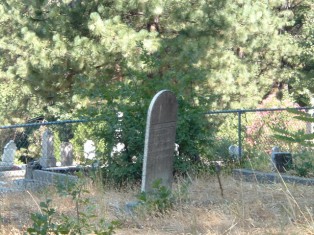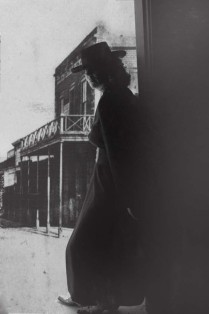It was the news of gold that let loose a flood of humanity upon the foothills of Northern California. Prior to 1849 most west-heading wagons were bound for Oregon. All at once settlers burst onto the scene searching for their fortune in gold. Some found what they hoped for, but others found nothting but tragedy. Such was the case for the Apperson family, pioneers who lost a young family member in a fiery accident in 1858. The wagon train the sojourners were a part of struggled to make its way over the treacherous Sierra Nevadas and down the other side into the valley below. The appersons and their fellow travelers were exhausted from the four-month overland trip, which had started in Independence, Missouri. After reaching the outskirts of the mining community of Nevada City, California, they made camp as usual and rested for a few days before moving the train on into town. The forest settling was idyllic, and the Appersons decided to stay there instead of going on with the others. They built a home for themselves and their four children. For a while they were truly happy. But on May 6, 1858, an unfortunate accident occurred that left them devastated. At their father’s request the Apperson children were dutifully burning household debris when the youngest boy, barely two years old, wandered too close to the flames, and his pant leg caught fire. His sister and brothers tried desperately to extinguish the flames but were unsussessful. The boy’s mother heard his frantic screams and hurried to her child. She smothered him with her dress and apron, and then quickly rushed him to a nearby waterng trough and immersed his body. The child’s legs and sides were severly burned, but he survived. For a time it seemed as though his injuries might not be life threatening. The boy lingered for a month and then died. He was buried at the southwest corner of their property. The Apperson family stayed only a few months after his death and then moved on. At the time of his passing, the grave was marked only by two small seedlings. Since then concerned neighbors and community leaders have taken an interest in the burial site, surrounding the small spot with a fence and a marker. Motorists driving along U.S. Highway 20 from Nevada City frequently stop to visit the lone grave beside the road. It lies to one side of the interstate between two large cedars. A stone plaque now stands over the place where the child lies. Donated by the Native Sons of the Golden West, the plaque reads Julius Albert Apperson, Born June 1855. Died May 6, 1858. A Pioneer Who Crossed The Plain To California Who Died And Was Buried Here. The Emigrant Trail followed along the ridge and through Nevada City. The marking of this lone grave perpetuates the memory of all the lone graves throughout the state. Not only does the plaque signify the grave as a historic landmark, it stands as a symbol of sacrifice.
Journal Notes
Outcast Cemetery
Sam Sixkiller Now Available

Sam Sixkiller was one of the most accomplished lawmen in 1880s Oklahoma Territory. And in many ways, he was a typical law-enforcement official, minding the peace and gunslinging in the still-wild West. What set Sam Sixkiller apart was his Cherokee heritage. Sixkiller’s sworn duty was to uphold the law, but he also took it upon himself to protect the traditional way of life of the Cherokee. Sixkiller’s temper, actions, and convictions earned him more than a few enemies, and in 1886 he was assassinated in an ambush. This new biography takes a sweeping, cinematic look at the short, tragic life of Sam Sixkiller and his days policing the streets of the Wild West.
Object Matrimony Available in bookstores everywhere October 2, 2012
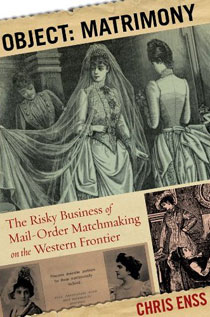
Desperate to strike it rich or eager for free land, men went into the frontier West alone and sacrificed many creature comforts. Only after they arrived at their destinations did some of them realize how much they missed female companionship.
One way for men living on the frontier to meet women was through subscriptions to heart-and-hand clubs. The men received newspapers with information about women with whom they could correspond—sometimes with photographs. Eventually a man might convince a woman to join him in the West, and in matrimony.
Complete with historic photographs and actual advertisements from both women seeking husbands and men seeking brides, Object Matrimony includes stories of courageous mail order brides and their exploits as well as stories of the marriage brokers, the mercenary matchmakers looking to profit off of the miners and settlers. Some of these stories end happily ever after; others reveal desperate situations that robbed the brides of their youth and sometimes their lives.
More Outlaw Tales of California Available in October of 2012
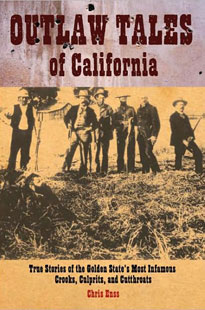
From the world-famous to the relatively obscure, Outlaw Tales of California features true tales of fifteen bandits, outlaws, and no-good scoundrels. From Sacramento to Los Angeles, San Francisco to Nevada City, the frontier towns of California were populated by some of the toughest and most dangerous characters in the West. Tom Bell, the flat-nosed, felon doctor had his “Catch me if you can!” motto finally catch up to him when he was hanged after a wild eighteen-month career as an outlaw. Lawman-gone-bad Henry Plummer got twisted up in a lascivious love affair. And bad luck bandit Dick Fellows never could catch a break—except for in his leg and ankle. From Charles Earl “Black Bart” Boles to “Rattlesnake Dick” Barter, Juan Flores to Joaquin Murieta, read about the most notorious desperados in the history of the Golden State. Through these astonishing true stories, Outlaw Tales of California introduces you to a state you thought you knew—and a West that was wilder than you’ve ever imagined.
Confessions of a Killer
Thunder Over the Prairie Soon to be a Major Motion Picture
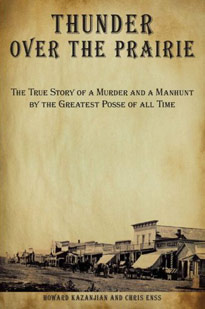
The year was 1878. Future legends of the Old West–lawmen Charlie Bassett, Bat Masterson, Wyatt Earp, and Bill Tilghman–patrolled the unruly streets of Dodge City, Kansas, then known as “the wickedest little city in America.”
When a cattle baron fled town after allegedly shooting the popular dancehall girl Dora Hand, these four men–all sharpshooters who knew the surrounding harsh, desertlike terrain–hunted him down, it was said, like “thunder over the prairie.” The posse’s legendary ride across the desolate landscape to seek justice influenced the men’s friendship, careers, and feelings about the justice system. This account of that event is a fast-paced, unforgettable glimpse into the Old West.
The Last Stage Robbery
Ghosts of Bodie
Mr. Colt
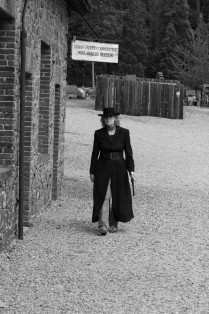 In every good western, whether it’s a book or a film, the bad guy more often than not get’s what’s coming to him in the end. That’s what makes westerns so attractive to me and hundreds of thousands of others. There’s something satisfying about a bully getting humiliated, a thief getting tossed in jail and a murderer being gunned down. I can’t help but think that’s part of what motivated inventor Samuel Colt to patent the revolving-camber pistol. Colt had a rough childhood. His mother died young from tuberculosis, he lost a sister to the same disease, and two of his other siblings committed suicide. At the age of eleven Colt was forced to work for a farmer who treated him cruelly. As soon as he was old enough he ran away. He went to work as a sailor and spent long hours staring at the ship’s wheel. He used this principle to invent a gun that could shoot multiple bullets without reloading. He excelled at both invention and marketing and today would be considered a compulsive workaholic. He struggled with a way to produce his guns cheaply but was forced to find a method of mass production after he received and order from the U.S. government in 1847 for 1,000 revolvers. By the time he died of exhaustion at age forty-seven, Samuel Colt had produced more than 400,000 Colt .45 revolvers. At his funeral in 1862 it was said of the Colt .45 he invented: “God created man, but Sam Colt [the Colt .45] made them all equal.” In 1873 the Colt SAA sold for $17.50. The complete kit with a holster and some ammunition could be covered by a $20 gold piece. The $20 Double Eagle of 1873 contained 0.9675 ounces of pure gold. Today an ounce of gold is about $1,090 and a new Colt SAA can be special ordered from Colt’s custom shop for about $1,500. It is fair to say that the invention of the Colt revolver changed the course of American history. It aided the westward expansion of America and the simplicity and effectiveness of the Colt revolver design is evidenced in the fact that they are still made and used today, both in the armed forces and in the private sector. Many have called the Colt repeating pistol the finest gun ever made. It was referred to as “law and order in six-finger doses.”
In every good western, whether it’s a book or a film, the bad guy more often than not get’s what’s coming to him in the end. That’s what makes westerns so attractive to me and hundreds of thousands of others. There’s something satisfying about a bully getting humiliated, a thief getting tossed in jail and a murderer being gunned down. I can’t help but think that’s part of what motivated inventor Samuel Colt to patent the revolving-camber pistol. Colt had a rough childhood. His mother died young from tuberculosis, he lost a sister to the same disease, and two of his other siblings committed suicide. At the age of eleven Colt was forced to work for a farmer who treated him cruelly. As soon as he was old enough he ran away. He went to work as a sailor and spent long hours staring at the ship’s wheel. He used this principle to invent a gun that could shoot multiple bullets without reloading. He excelled at both invention and marketing and today would be considered a compulsive workaholic. He struggled with a way to produce his guns cheaply but was forced to find a method of mass production after he received and order from the U.S. government in 1847 for 1,000 revolvers. By the time he died of exhaustion at age forty-seven, Samuel Colt had produced more than 400,000 Colt .45 revolvers. At his funeral in 1862 it was said of the Colt .45 he invented: “God created man, but Sam Colt [the Colt .45] made them all equal.” In 1873 the Colt SAA sold for $17.50. The complete kit with a holster and some ammunition could be covered by a $20 gold piece. The $20 Double Eagle of 1873 contained 0.9675 ounces of pure gold. Today an ounce of gold is about $1,090 and a new Colt SAA can be special ordered from Colt’s custom shop for about $1,500. It is fair to say that the invention of the Colt revolver changed the course of American history. It aided the westward expansion of America and the simplicity and effectiveness of the Colt revolver design is evidenced in the fact that they are still made and used today, both in the armed forces and in the private sector. Many have called the Colt repeating pistol the finest gun ever made. It was referred to as “law and order in six-finger doses.”

